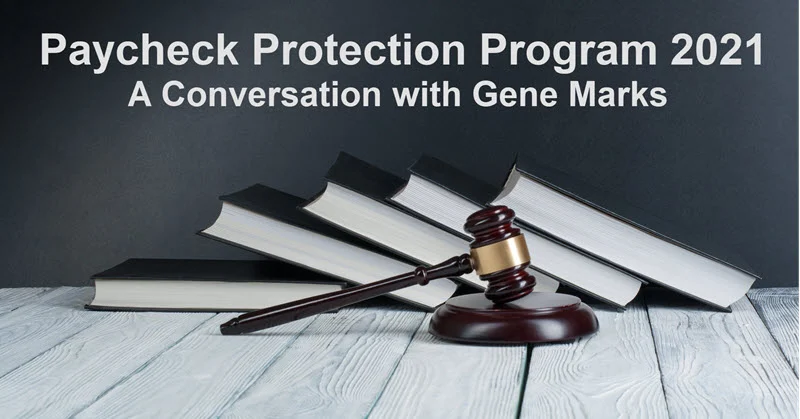Joining us today is Gene Marks from the Marks Group PC. He is an author, a speaker on small business expertise, and a CPA. He has presented at Scaling New Heights. He was one of our guests on the Round Tables back in March for the CARES Act when we were trying to figure out what was happening with coronavirus relief. He writes regularly for The Hill, the Philadelphia Inquirer, Forbes, Entrepreneur Magazine, and The Guardian, and appears regularly on MSNBC, CNBC, Fox Business and Fox News. He’s the author of six books on business management and comes to us today compliments of our friends at Patriot Software, a leading payroll provider which works with QuickBooks Integrated Payroll.
Joe Woodard: So what if somebody is still sitting on some of those dollars and hasn't spent them yet? Does that impact PPP?
Gene Marks: No, it does not. Now let’s talk about economic injury disaster loans (EIDLs). You get these directly from the SBA rather than through lenders. The SBA has to approve the final amount and it is capping many of them at $150,000 but the terms are still the same. EIDLs are 30-year loans at 3.75% interest for for-profit companies and 2.75% interest for nonprofits. Another $20 billion was allocated to this program. So you can apply for an EIDL loan. The application for an EIDL is changing to protect the SBA against fraud. But the nature of this program is that companies receiving them are in disaster areas of the country. This isn’t new-this program has been in existence for decades. The barriers for getting approved for EIDLs are pretty low. But there have been changes to this program. You can definitely get an EIDL if you have a PPP loan. So they're really separating these two programs. The EIDL is not a forgivable loan; you have to pay it back.
The advances in grants are changing a little bit. If you remember, during the first round of the EIDL you could apply for an advance of $1,000 per employee up to $10,000. The rule used to be that if you also got a PPP loan, you had to take the advance out of the non-forgivable portion of the PPP loan. And that created a lot of confusion. That’s gone away. If you get an advance under the EIDL now and going forward, it’s separate from your PPP loan. The advance no longer has to be taken against the PPP loan. You can still have your PPP loan fully forgiven.
And if you're a minority-owned business (this includes women, Blacks and Hispanics) in a lower- or moderate-income area, you can get a $10,000 advance grant even if you are turned down for an EIDL. The SBA now will take about three weeks to decide on that before the time was a lot more limited, but the money is there. If you previously applied for an EIDL and an advance because you’re a minority-owned business, but the money ran out before you could get the advance, the SBA will make good on that advance. If you were entitled to an advance but received only a partial payment, the SBA will pay you the remainder from your additional EIDL. You can only get one month’s advance.
Joe Woodard: And you can only get one loan between both sets of legislation. If a business already got the EIDL and the $10,000 advance because they’re minority-owned, they’re not eligible for the PPP loan.
Gene Marks: That's correct. But the issue with this round is that in the first round, minority-owned businesses received a disproportionate lower amount of funding under the legislation. Congress wanted to address that and make sure they get all the funding that they needed. So the idea is to get the money out to those minority-owned businesses and to give them that much incentive to apply for these loans.
Joe Woodard: PPP proceeds that are forgiven do not qualify as gross receipts under the legislation.
Gene Marks: Let's talk taxes for a little bit. Your PPP loan would not qualify as gross receipts. If it's forgiven, it is not taxable. It’s like extraordinary income. Everybody was yelling and screaming about deductions and the fact that the loans weren't taxable, but any expenses that you used for forgiveness would not be deductible under the old legislation. But under the new legislation, any expenses that you use for forgiveness are now deductible as well. So the fear that PPP loans and forgiveness would generate tax liability has now gone away. We get all the tax benefits. We're literally being allowed to double dip, which is great.
Joe Woodard: All right, so I've got another question here. Getting back to the quarters, is it always Q1 compared to Q1 or you cannot take any quarter in 2020, or is it Q1 compared to any quarter and 2019?
Gene Marks: It's got to be the quarter, and then the same corresponding quarter from last year. That's what the rules are. There are going to be some rules and new clarifications on seasonal businesses as well.
Joe Woodard: So if a business only operated in Q4 of 2019, they can only compare Q4 2020 to Q4 2019 now. What if somebody didn't operate in 2019 but they operated before February 15 in 2020?
Gene Marks: You're allowed to take whatever complete quarters you were in business in 2019 and use that as corresponding quarters, so if you started up in the fourth quarter of 2019 and they had a full quarter of 2019 you can compare any of your quarters for 2020 to the fourth quarter of 2019.
Joe Woodard: I see. If a corporation didn't operate except one quarter, but it existed but was dormant for three of the four quarters and became active in Q4, how does that work?
Gene Marks: I don't know the answer to that. I mean, I think that the way that I would position that with my lender is that we filed the papers and incorporated. But, you know, our business officially started up when we received our first revenues. There has to be be some trigger that you would define as a startup.
Joe Woodard: The worst case scenario is, they still just make you go Q4 to Q4, but they might let you do what you talked about: compare any quarter.
.png?width=150&height=63&name=TWRlogo-regmark_blueblack%20(1).png)
.png)










Do you have questions about this article? Email us and let us know > info@woodard.com
Comments: